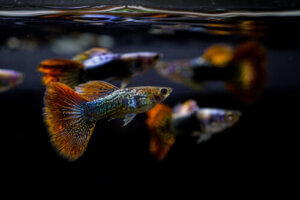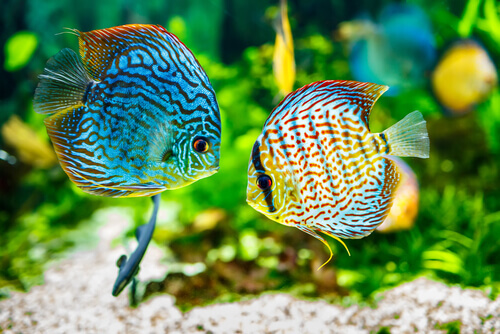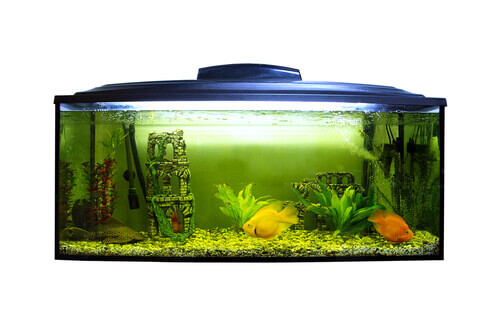The Importance of the pH of an Aquarium

To guarantee the well-being of your aquarium fish and plants, you’ll need to maintain their aquarium properly. You’ll need to take many different factors into account, such as temperature, salinity, water hardness, and pH. Read on, as we take a closer look at the importance of the pH of an aquarium.
What is the pH of an aquarium?
PH is a variable that measures the acidity level of a solution, which is linked to the concentration of hydrogen ions (H+). This variable is measured on a scale from 0 to 14. A pH value of 7 corresponds to neutral substances, such as pure water.
Acidic substances are those with a pH lower than 7 while basic substances have a pH higher than 7.
Water usually has a neutral value. We need to bear in mind, though, that a small difference in pH might not affect us, but could have a significant impact on aquarium plants and animals.
How do you measure the pH of an aquarium?
Now let’s see the most effective commercial methods to measure the pH of an aquarium:
- A pH meter. This instrument consists of two electrodes, one reference electrode and one sensitive to hydrogen ions. The meter uses the difference between the measurements of each electrode and converts it into pH units. to start using the pH meter, you’ll need to calibrate it first before putting it into the aquarium water.
- PH strips. These are less accurate than a pH meter, but they are easy to use and much cheaper. These are paper strips that show a different color depending on the acidity or alkalinity of the water.
What is the ideal pH for an aquarium?
The ideal pH varies depending on the species that you have in your aquarium. There’s no standard level for all fish, although most fish can survive in a range between 5.5 to 8.0.
- The recommended pH for coastal species is between 6.5 and 8.5
- Amazonian species, such as Guppy and Betta, should have between 6 and 7.
- East African fish, such as African cichlids, would need between 7.5 and 8.
- Goldfish, the world’s best-known species of fish, prefer neutral waters with a pH of 7 or 7.5.
There is also an ideal pH for aquarium plants. For example, Ceratophyllum demersum or coontail, is a specimen widely used in aquariums. This plant lives best in a pH of 6.5 to 7. On the other hand, Java Moss prefers acidic waters below 7, although it can survive in a broad pH range from 5 to 8.
The pH is not a fixed parameter since it can vary according to the type of substrate, the food remains, the decomposition of plants, the organic waste of fish, the temperature, or the CO2 level. In turn, a variation of the pH level can influence other measurements, such as water hardness.

How does pH affect fish?
Fish have physiological mechanisms to adapt to changes in pH within a small range. When you introduce a new fish into the aquarium, they need to undergo an acclimatization process.
The carbonic anhydrase enzyme contributes to the regulation of the pH inside an animal. If their blood becomes t0o acidic, for example, from an excess of CO2 in an aquarium, the plasma bicarbonate ion rate increases to compensate for the pH imbalance.
Then, the entering of CO2 and the elimination of bicarbonate ions contribute to lowering the pH of the blood.

Problems with pH
This capacity to self-regulate is much more developed in species that live in extreme pH levels. However, tropical marine fish have adapted to greater pH stability because of the reefs. This means that minimal variations (up to 0.1) could cause symptoms of acidosis or alkalosis:
- Acidosis. This occurs due to a sudden drop in pH. The fish may lose mobility, appetite, increase mucous secretion, and their gills may change color. This can affect hemoglobin, causing the animal not to breathe properly and become disoriented. They can also have a tendency to jump out of the water. In extreme cases, this can cause the animal to die.
- Alkalosis. Although this is less common, it’s more frequent when animals arrive home after transportation. The bag that contains them for hours can become alkaline. If this occurs, you can see respiratory symptoms, inconsistent swimming, and a pale color.
As we’ve seen, the pH of the water is essential for the survival and well-being of aquarium fish. Therefore, performing weekly tests to measure the pH is essential to ensure that you have a balanced aquatic ecosystem.
To guarantee the well-being of your aquarium fish and plants, you’ll need to maintain their aquarium properly. You’ll need to take many different factors into account, such as temperature, salinity, water hardness, and pH. Read on, as we take a closer look at the importance of the pH of an aquarium.
What is the pH of an aquarium?
PH is a variable that measures the acidity level of a solution, which is linked to the concentration of hydrogen ions (H+). This variable is measured on a scale from 0 to 14. A pH value of 7 corresponds to neutral substances, such as pure water.
Acidic substances are those with a pH lower than 7 while basic substances have a pH higher than 7.
Water usually has a neutral value. We need to bear in mind, though, that a small difference in pH might not affect us, but could have a significant impact on aquarium plants and animals.
How do you measure the pH of an aquarium?
Now let’s see the most effective commercial methods to measure the pH of an aquarium:
- A pH meter. This instrument consists of two electrodes, one reference electrode and one sensitive to hydrogen ions. The meter uses the difference between the measurements of each electrode and converts it into pH units. to start using the pH meter, you’ll need to calibrate it first before putting it into the aquarium water.
- PH strips. These are less accurate than a pH meter, but they are easy to use and much cheaper. These are paper strips that show a different color depending on the acidity or alkalinity of the water.
What is the ideal pH for an aquarium?
The ideal pH varies depending on the species that you have in your aquarium. There’s no standard level for all fish, although most fish can survive in a range between 5.5 to 8.0.
- The recommended pH for coastal species is between 6.5 and 8.5
- Amazonian species, such as Guppy and Betta, should have between 6 and 7.
- East African fish, such as African cichlids, would need between 7.5 and 8.
- Goldfish, the world’s best-known species of fish, prefer neutral waters with a pH of 7 or 7.5.
There is also an ideal pH for aquarium plants. For example, Ceratophyllum demersum or coontail, is a specimen widely used in aquariums. This plant lives best in a pH of 6.5 to 7. On the other hand, Java Moss prefers acidic waters below 7, although it can survive in a broad pH range from 5 to 8.
The pH is not a fixed parameter since it can vary according to the type of substrate, the food remains, the decomposition of plants, the organic waste of fish, the temperature, or the CO2 level. In turn, a variation of the pH level can influence other measurements, such as water hardness.

How does pH affect fish?
Fish have physiological mechanisms to adapt to changes in pH within a small range. When you introduce a new fish into the aquarium, they need to undergo an acclimatization process.
The carbonic anhydrase enzyme contributes to the regulation of the pH inside an animal. If their blood becomes t0o acidic, for example, from an excess of CO2 in an aquarium, the plasma bicarbonate ion rate increases to compensate for the pH imbalance.
Then, the entering of CO2 and the elimination of bicarbonate ions contribute to lowering the pH of the blood.

Problems with pH
This capacity to self-regulate is much more developed in species that live in extreme pH levels. However, tropical marine fish have adapted to greater pH stability because of the reefs. This means that minimal variations (up to 0.1) could cause symptoms of acidosis or alkalosis:
- Acidosis. This occurs due to a sudden drop in pH. The fish may lose mobility, appetite, increase mucous secretion, and their gills may change color. This can affect hemoglobin, causing the animal not to breathe properly and become disoriented. They can also have a tendency to jump out of the water. In extreme cases, this can cause the animal to die.
- Alkalosis. Although this is less common, it’s more frequent when animals arrive home after transportation. The bag that contains them for hours can become alkaline. If this occurs, you can see respiratory symptoms, inconsistent swimming, and a pale color.
As we’ve seen, the pH of the water is essential for the survival and well-being of aquarium fish. Therefore, performing weekly tests to measure the pH is essential to ensure that you have a balanced aquatic ecosystem.
All cited sources were thoroughly reviewed by our team to ensure their quality, reliability, currency, and validity. The bibliography of this article was considered reliable and of academic or scientific accuracy.
- Cultura científica. ¿Qué es el pH?,2019.
- Peces de acuario.net
- Acuarema.com
- La guía del acuario
- Richar W Hill. Fisiología animal comparada.
This text is provided for informational purposes only and does not replace consultation with a professional. If in doubt, consult your specialist.








